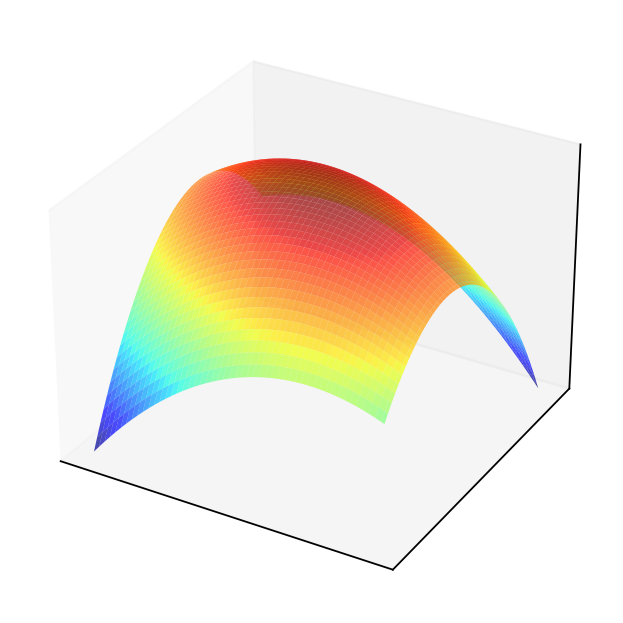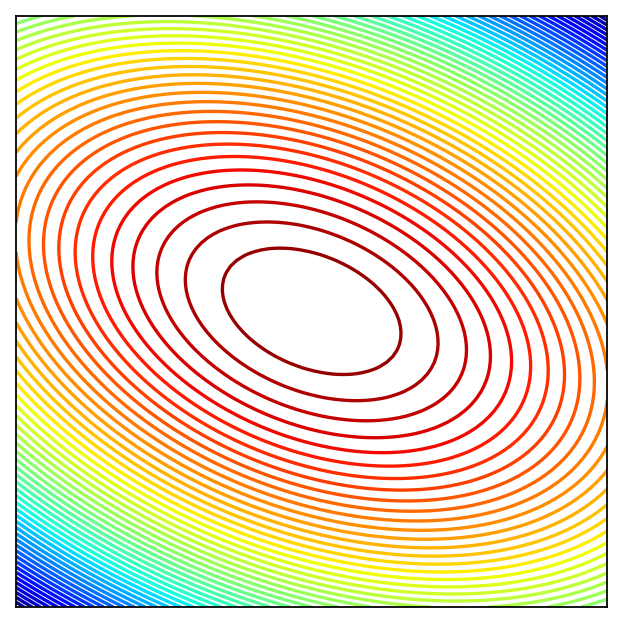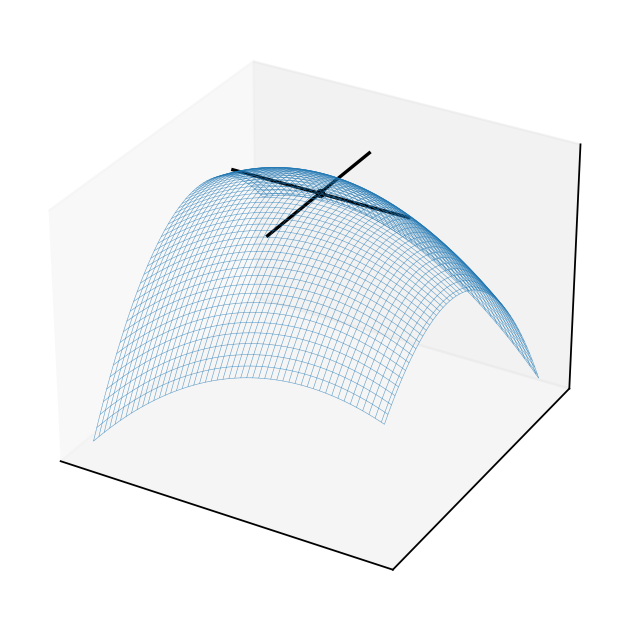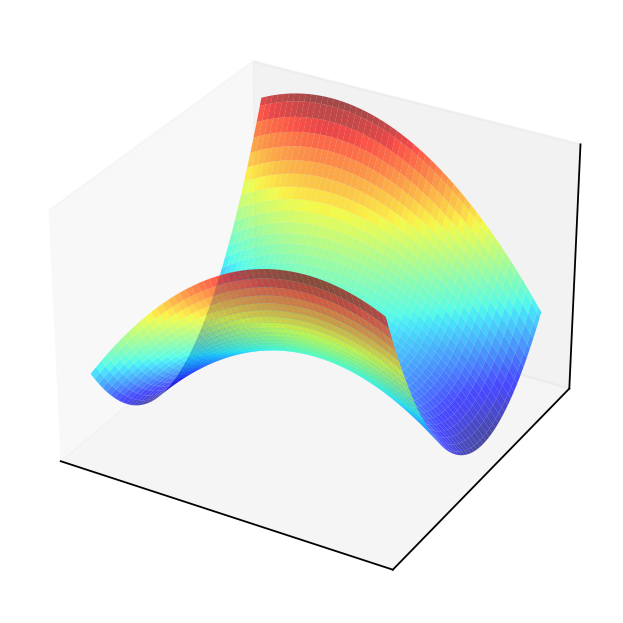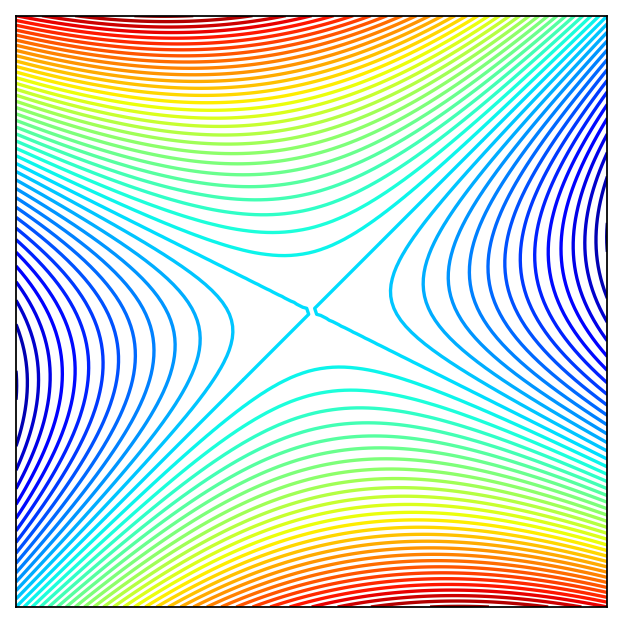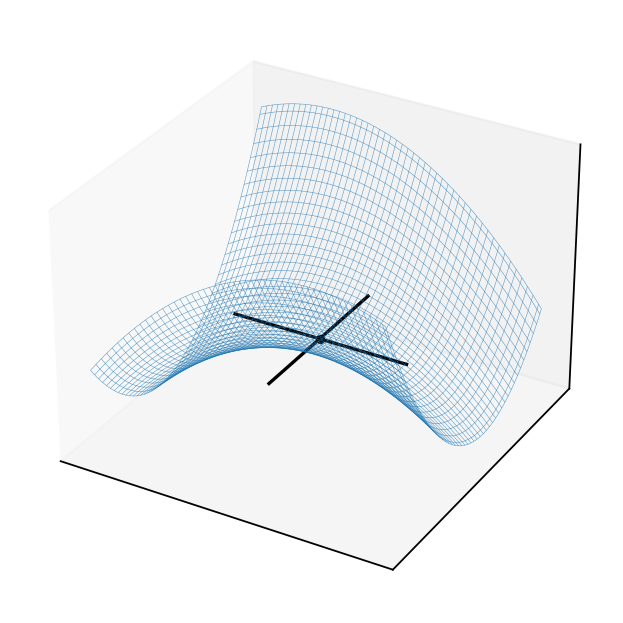Unconstrained optimization#
ECON2125/6012 Lecture 7 Fedor Iskhakov
Announcements & Reminders
Test 2 results and discussion
Exam is preliminary scheduled to Monday, 6 November 9:00 to 12:15
Plan for this lecture
Optimization problems in economics
Multivariate calculus
Necessary (first order) condition in \(\mathbb{R}^n\)
Sufficient (second order) and shape conditions
Supplementary reading:
Simon & Blume: 13.1, 13.2, 13.3, 14.1, 14.3, 14.4, 14.5, 14.8, whole of chapter 17
Sundaram: 1.4, 1.5, 2.1, 2.2, 4.1 to 4.4
An optimization problem#
Example
Consider a (monopolistic) firm that is facing a market demand for its products \(D(p) = \alpha + \frac{1}{4\alpha}p^2-p\) and the cost of production \(C(q) = \beta q + \delta q^2\). As usual, \(p\) and \(q\) denote price and quantity of product, respectively.
To maximize its profit \(\pi(p,q) = pq-C(q)\), the firm solves the following optimization problem
Plugging in the functions \(D(p)\) and \(C(q)\) we have an equivalent formulation
Components of the optimization problem#
Objective function: function to be maximized or minimized, also known as maximand
In the example above profit function \(\pi(p,q) = pq - C(q)\) to be maximizedDecision/choice variables: the variables that the agent can control in order to optimize the objective function, also known as controls
In the example above price \(p\) and quantity \(q\) variables that the firm can choose to maximize its profitEquality constraints: restrictions on the choice variables in the form of equalities
In the example above \(q = \alpha + \frac{1}{4\alpha}p^2-p\)Inequality constraints (weak and strict): restrictions on the choice variables in the form of inequalities
In the example above \(q \ge 0\) and \(p > 0\)Parameters: the variables that are not controlled by the agent, but affect the objective function and/or constraints
In the example above \(\alpha\), \(\beta\) and \(\delta\) are parameters of the problemValue function: the “optimized” value of the objective function as a function of parameters
In the example above \(\Pi(\alpha,\beta,\delta)\) is the value function
Definition
The general form of the optimization problem is
where:
\(f(x,\theta) \colon \mathbb{R}^N \times \mathbb{R}^K \to \mathbb{R}\) is an objective function
\(x \in \mathbb{R}^N\) are decision/choice variables
\(\theta \in \mathbb{R}^K\) are parameters
\(g_i(x,\theta) = 0, \; i\in\{1,\dots,I\}\) where \(g_i \colon \mathbb{R}^N \times \mathbb{R}^K \to \mathbb{R}\), are equality constraints
\(h_j(x,\theta) \le 0, \; j\in\{1,\dots,J\}\) where \(h_j \colon \mathbb{R}^N \times \mathbb{R}^K \to \mathbb{R}\), are inequality constraints
\(V(\theta) \colon \mathbb{R}^K \to \mathbb{R}\) is a value function
Definition
The set of admissible choices (admissible set) contains all the choices that satisfy the constraints of the optimization problem.
Note
Sometimes the equality constraints are dropped from the definition of the optimization problem, because they can always be represented as a pair of inequality constraints \(g_i(x,\theta) \le 0\) and \(-g_j(x,\theta) \le 0\)
Note
Note that strict inequality constraints are not present in the definition above, although they may be present in the economic applications. You already know that this has to do with the intention to keep the set of admissible choices closed, such that the solution of the problem (has a better chance to) exist. Sometimes they are added to the definition.
A roadmap for formulating an optimization problem (in economics)
Determine which variables are choice variables and which are parameters according to what the economic agent has control over
Determine whether the optimization problem is a maximization or a minimization problem
Determine the objective function of the economic agent (and thus the optimization problem)
Determine the constraints of the optimization problem: equality and inequality, paying particular attention to whether inequalities should be strict or weak (the latter has huge implications for the existence of the solution)
Example
Consider a decision maker who is deciding how to divide the money they have between food and services, bank deposit and buying some crypto. Discuss and Write down the corresponding optimization problem. [class exercise]
Classes of the optimization problems#
Static optimization: finite number of choice variables
singe instance of choice
deterministic finite horizon dynamic choice models can be represented as static
our main focus in this course
Dynamic programming: some choice variables are infinite sequences, solved using similar techniques as static optimization
will touch upon in the end of the course
Deterministic optimal control: some “choice variables” are functions, completely new theory is needed
Stochastic optimal control: “choice variables” are functions, objective function is a stochastic process, yet more theory is needed
Review of one-dimensional optimization#
Let \(f \colon [a, b] \to \mathbb{R}\) be a differentiable function
\(f\) takes \(x \in [a, b] \subset \mathbb{R}\) and returns number \(f(x)\)
derivative \(f'(x)\) exists for all \(x\) with \(a < x < b\)
Differentiability implies that \(f\) is continuous, and because the interval \([a,b]\) is closed and bounded, \(f\) has a maximum and a minimum on \([a,b]\) by the Weierstrass extreme value theorem.
Reminder of definitions
A point \(x^* \in [a, b]\) is called a
maximizer of \(f\) on \([a, b]\) if \(f(x^*) \geq f(x)\) for all \(x \in [a,b]\)
minimizer of \(f\) on \([a, b]\) if \(f(x^*) \leq f(x)\) for all \(x \in [a,b]\)
Point \(x\) is called interior to \([a, b]\) if \(a < x < b\)
A stationary point of \(f\) on \([a, b]\) is an interior point \(x\) with \(f'(x) = 0\)
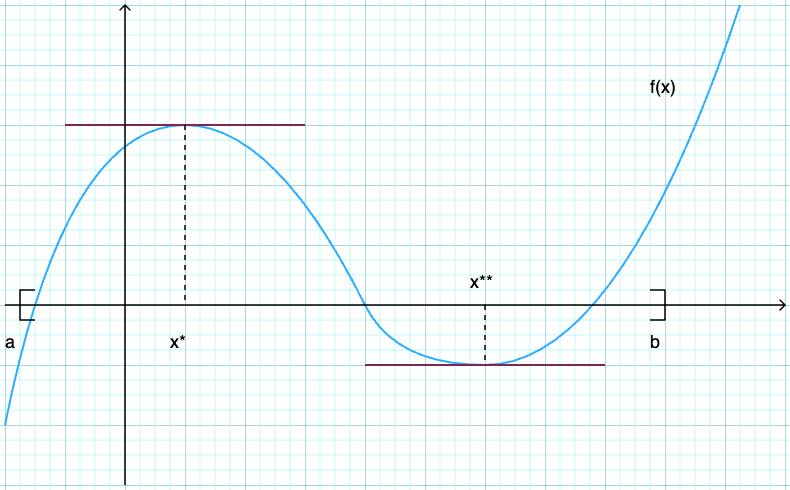
Fig. 83 Both \(x^*\) and \(x^{**}\) are stationary#
Fact
If \(f\) is differentiable and \(x^*\) is either an interior minimizer or an interior maximizer of \(f\) on \([a, b]\), then \(x^*\) is stationary
\(\Rightarrow\) any interior maximizer stationary
\(\Rightarrow\) set of interior maximizers \(\subset\) set of stationary points
\(\Rightarrow\) maximizers \(\subset \text{stationary points} \cup \{a\} \cup \{b\}\)
Algorithm for finding maximizers/minimizers:
Locate stationary points
Evaluate \(y = f(x)\) for each stationary \(x\) and for \(a\), \(b\)
Pick point giving largest \(y\) value
Sufficiency and uniqueness with shape conditions#
Fact
Sufficient conditions for concavity in one dimension
Let \(f \colon [a, b] \to \mathbb{R}\)
If \(f''(x) \leq 0\) for all \(x \in (a, b)\) then \(f\) is concave on \((a, b)\)
If \(f''(x) < 0\) for all \(x \in (a, b)\) then \(f\) is strictly concave on \((a, b)\)
Sufficient conditions for convexity in one dimension
Let \(f \colon [a, b] \to \mathbb{R}\)
If \(f''(x) \geq 0\) for all \(x \in (a, b)\) then \(f\) is convex on \((a, b)\)
If \(f''(x) > 0\) for all \(x \in (a, b)\) then \(f\) is strictly convex on \((a, b)\)
Fact
For maximizers:
If \(f \colon [a,b] \to \mathbb{R}\) is concave and \(x^* \in (a, b)\) is stationary then \(x^*\) is a maximizer
If, in addition, \(f\) is strictly concave, then \(x^*\) is the unique maximizer
For minimizers:
If \(f \colon [a,b] \to \mathbb{R}\) is convex and \(x^* \in (a, b)\) is stationary then \(x^*\) is a minimizer
If, in addition, \(f\) is strictly convex, then \(x^*\) is the unique minimizer
Let us generalize these results to the multivariate case.
Multivariate calculus#
Reminder of the derivative in one dimension
Let \(f \colon (a, b) \to \mathbb{R}\) and let \(x \in (a, b)\)
Let \(H\) be all sequences \(\{h_n\}\) such that \(h_n \ne 0\) and \(h_n \to 0\)
If there exists a constant \(f'(x)\) such that
for every \(\{h_n\} \in H\), then
\(f\) is said to be differentiable at \(x\)
\(f'(x)\) is called the derivative of \(f\) at \(x\)
In higher dimensions this definition has to be adjusted to account for the fact that \(h_n\) is a vector in \(\mathbb{R}^N\)
Definition
Let
\(A \subset \mathbb{R}^N\) be an open set in \(N\)-dimensional space.
\(f \colon A \to \mathbb{R}^K\) be a \(K\) dimensional vector function
\({\bf x} \in A\), and so \(\exists \epsilon \colon B_{\epsilon}({\bf x}) \subset A\)
Then if there exists a \(K \times N\) matrix \(J\) such that
for all converging to zero sequences \(\{{\bf h}_n\}\), \({\bf h}_n \in B_{\epsilon}({\bf 0}) \setminus \{{\bf 0}\}\), \({\bf h}_n \to {\bf 0}\), then
\(f\) is said to be differentiable at \({\bf x}\)
matrix \(J\) is called the total derivative (or Jacobian matrix) of \(f\) at \({\bf x}\), and is denoted by \(Df({\bf x})\) or simply \(f'({\bf x})\)
Note
The vector function \(f \colon \mathbb{R}^N \to \mathbb{R}^K\) (also known as vector-valued function) can be thought of as a tuple of \(K\) functions \(f_j \colon \mathbb{R}^N \to \mathbb{R}\), \(j \in \{1, \dots, K\}\)
Contrast the definition of total derivative to the definition of the partial derivative
Definition
Let \(f \colon A \to \mathbb{R}\) and let \({\bf x} \in A \subset \mathbb{R}^N\). Denote \({\bf e}_i\) the \(i\)-th unit vector in \(\mathbb{R}^N\), i.e. \({\bf e}_i = (0, \dots, 0, 1, 0, \dots, 0)\) where \(1\) is in the \(i\)-th position.
If there exists a constant \(a \in \mathbb{R}\) such that
for every sequence \(\{h_n\}\), \(h_n \in \mathbb{R}\), such that \(h_n \ne 0\) and \(h_n \to 0\) as \(n \to \infty\), then \(a\) is called a partial derivative of \(f\) with respect to \(x_i\) at \({\bf x}\), and is denoted \(f'_i({\bf x})\) or \(\frac{\partial f}{\partial x_i}({\bf x})\)
Total derivative of \(f \colon \mathbb{R}^N \to \mathbb{R}^K\) defines a linear map \(J \colon \mathbb{R}^N \to \mathbb{R}^K\) given by \(K \times N\) matrix \(Df(x)\) which gives a affine approximation of function \(f\) by a tangent hyperplane at point \({\bf x}\). This is similar to the tangent line to a one-dimensional function determined by a derivative at any given point.
Fact
If a vector function \(f \colon \mathbb{R}^N \to \mathbb{R}^K\) is differentiable at \({\bf x}\), then all partial derivatives at \({\bf x}\) exist and the total derivative (Jacobian) is given by
Fact
If all partial derivatives of \(f \colon \mathbb{R}^N \to \mathbb{R}^K\) exist and are continuous in \({\bf x}\), then \(f\) is differentiable at \({\bf x}\)
The last two facts can be stated for sets by adding the condition that the statements hold in all elements on the sets (such as “for all \({\bf x} \in A\)”)
Example
Partial derivatives are
Jacobian matrix is
Now, evaluating at a particular points
Example
Exercise: Derive Jacobian maxtix of \(f\) and compute the total derivative of \(f\) at \({\bf x} = (1, 0, 2)\)
Definition
For a function \(f \colon \mathbb{R}^N \to \mathbb{R}\) the Jacobian matrix takes is \(1 \times N\) vector which is called gradient and is often denoted \(\nabla f({\bf x}) \in \mathbb{R}^N\)
Rules of differentiation#
Fact
Let \(A\) denote an open set in \(\mathbb{R}^N\) and let \(f, g \colon A \to \mathbb{R}^K\) be differentiable functions at \({\bf x} \in A\).
\(f+g\) is differentiable at \({\bf x}\) and \(D(f+g)({\bf x}) = Df({\bf x}) + Dg({\bf x})\)
\(cf\) is differentiable at \({\bf x}\) and \(D(cf)({\bf x}) = c Df({\bf x})\) for any scalar \(c\)
Fact: Product (Leibniz) rule
Let \(A\) denote an open set in \(\mathbb{R}^N\) and let \(f \colon A \to \mathbb{R}\) and \(g \colon A \to \mathbb{R}^K\) be both differentiable functions at \({\bf x} \in A\).
Then \(f g\) is differentiable at \({\bf x}\) and \(D(f g)({\bf x}) = f({\bf x}) Dg({\bf x}) + g({\bf x}) \nabla f({\bf x})\)
Fact: Dot product rule
Let \(A\) denote an open set in \(\mathbb{R}^N\) and let \(f,g \colon A \to \mathbb{R}^K\) be both differentiable functions at \({\bf x} \in A\).
Then \(f \cdot g\) is differentiable at \({\bf x}\) and \(D(f \cdot g)({\bf x}) = [f({\bf x})]' Dg({\bf x}) + [g({\bf x})]' Df({\bf x})\), where \([\cdot]'\) denotes vector transpose
Fact: Chain rule
Let \(A\) denote an open set in \(\mathbb{R}^N\) and \(C\) denote an open set in \(\mathbb{R}^K\). Let \(f \colon A \to C\) be differentiable at \({\bf x} \in A\), and \(g \colon C \to \mathbb{R}^L\) be differentiable at \(f({\bf x}) \in C\).
Then the composition \(g \circ f\) is differentiable at \({\bf x}\) and its total derivatibe is given by \(D(g \circ f)({\bf x}) = Dg(f({\bf x})) Df({\bf x})\)
Example
Applying the chain rule
Now we can evaluate \(D(g \circ f)({\bf x})\) at a particular points in \(\mathbb{R}^3\)
Example
Exercise: Using the chain rule, find the total derivative of the composition \(g \circ f\).
The chain rule very powerful tool in computing complex derivatives (think backwards propagation in deep neural networks)
Higher order derivatives#
The higher order derivatives of the function in one dimension generalize naturally to the multivariate case, but the complexity of the needed matrixes and multidimensional arrays (tensors) grows fast.
Definition
Let \(A\) denote an open set in \(\mathbb{R}^N\), and let \(f \colon A \to \mathbb{R}\). Assume that \(f\) is twice differentiable at \({\bf x} \in A\).
The total derivative of the gradient of function \(f\) at point \({\bf x}\), \(\nabla f({\bf x})\) is called the Hessian matrix of \(f\) denoted by \(Hf\) or \(\nabla^2 f\), and is given by a \(N \times N\) matrix
Fact
For every \({\bf x} \in A \subset \mathbb{R}^N\) where \(A\) is an open and \(f \colon A \to \mathbb{R}^N\) is twice continuously differentiable, the Hessian matrix \(\nabla^2 f({\bf x})\) is symmetric
Example
Exercise: check
Example
Exercise: check
First oder conditions (FOC), necessary#
In this lecture we focus on the unconstrained optimization problems of the form
where \(f(x,\theta) \colon \mathbb{R}^N \to \mathbb{R}\) and unless stated otherwise is assumed to be continuous and twice continuously differentiable everywhere on \(\mathbb{R}^N\). Parameter \(\theta\) may or may not be present.
Note
Twice continuously differentiable functions are said to be \(C^2\).
Every point in the whole space \(\mathbb{R}^N\) is interior, therefore all maximizers/minimizers have to be stationary points
Assuming differentiability implies we can focus on derivative based conditions
Definition
Given a function \(f \colon \mathbb{R}^N \to \mathbb{R}\), a point \({\bf x} \in \mathbb{R}^N\) is called a stationary point of \(f\) if \(\nabla f({\bf x}) = {\bf 0}\)
Definition
Given a function \(f \colon \mathbb{R}^N \to \mathbb{R}\), a point \({\bf x^\star} \in \mathbb{R}^N\) is called a local maximizer/minimizer of \(f\) if \(\exists \epsilon\) such that \(f({\bf x}) \le f({\bf x^\star})\) for all \(x \in B_{\epsilon}({\bf x^\star})\)
If the inequality is strict, then \({\bf x^\star}\) is called a strict local maximizer/minimizer of \(f\)
A maximizer/minimizer (global) must also be a local one, but the opposite is not necessarily true.
Fact (Necessary condition for optima)
Let \(f(x,\theta) \colon \mathbb{R}^N \to \mathbb{R}\) be a differentiable function and let \({\bf x^\star} \in \mathbb{R}^N\) be a local maximizer/minimizer of \(f\).
Then \({\bf x^\star}\) is a stationary point of \(f\), that is \(\nabla f({\bf x^\star}) = {\bf 0}\)
Example
Consider quadratic form \(f({\bf x}) = {\bf x}' A {\bf x}\) where \(A = \left( \begin{array}{rr} 1,& 0.5 \\ 0.5,& 2 \end{array} \right)\)
Solving the FOC
The point \((0,0)\) should be an optimizer.
Show code cell source
import numpy as np
import matplotlib.pyplot as plt
from mpl_toolkits.mplot3d import Axes3D
from matplotlib import cm
A = np.array([[1,.5],[.5,2]])
f = lambda x: -(x@A@x)
x = y = np.linspace(-5.0, 5.0, 100)
X, Y = np.meshgrid(x, y)
zs = np.array([f((x,y)) for x,y in zip(np.ravel(X), np.ravel(Y))])
Z = zs.reshape(X.shape)
fig = plt.figure(dpi=160)
ax1 = fig.add_subplot(111, projection='3d')
ax1.plot_surface(X, Y, Z,
rstride=2,
cstride=2,
cmap=cm.jet,
alpha=0.7,
linewidth=0.25)
plt.setp(ax1,xticks=[],yticks=[],zticks=[])
fig = plt.figure(dpi=160)
ax2 = fig.add_subplot(111)
ax2.set_aspect('equal', 'box')
ax2.contour(X, Y, Z, 50,
cmap=cm.jet)
plt.setp(ax2, xticks=[],yticks=[])
fig = plt.figure(dpi=160)
ax3 = fig.add_subplot(111, projection='3d')
ax3.plot_wireframe(X, Y, Z,
rstride=2,
cstride=2,
alpha=0.7,
linewidth=0.25)
f0 = f(np.zeros((2)))+0.1
ax3.scatter(0, 0, f0, c='black', marker='o', s=10)
ax3.plot([-3,3],[0,0],[f0,f0],color='black')
ax3.plot([0,0],[-3,3],[f0,f0],color='black')
plt.setp(ax3,xticks=[],yticks=[],zticks=[])
plt.show()
Example
Consider quadratic form \(f({\bf x}) = {\bf x}' A {\bf x}\) where \(A = \left( \begin{array}{rr} 1,& 0.5 \\ 0.5,& -2 \end{array} \right)\)
Solving the FOC
The point \((0,0)\) should be an optimizer?
Show code cell source
import numpy as np
import matplotlib.pyplot as plt
from mpl_toolkits.mplot3d import Axes3D
from matplotlib import cm
A = np.array([[1,.5],[.5,-2]])
f = lambda x: -(x@A@x)
x = y = np.linspace(-5.0, 5.0, 100)
X, Y = np.meshgrid(x, y)
zs = np.array([f((x,y)) for x,y in zip(np.ravel(X), np.ravel(Y))])
Z = zs.reshape(X.shape)
fig = plt.figure(dpi=160)
ax1 = fig.add_subplot(111, projection='3d')
ax1.plot_surface(X, Y, Z,
rstride=2,
cstride=2,
cmap=cm.jet,
alpha=0.7,
linewidth=0.25)
plt.setp(ax1,xticks=[],yticks=[],zticks=[])
fig = plt.figure(dpi=160)
ax2 = fig.add_subplot(111)
ax2.set_aspect('equal', 'box')
ax2.contour(X, Y, Z, 50,
cmap=cm.jet)
plt.setp(ax2, xticks=[],yticks=[])
fig = plt.figure(dpi=160)
ax3 = fig.add_subplot(111, projection='3d')
ax3.plot_wireframe(X, Y, Z,
rstride=2,
cstride=2,
alpha=0.7,
linewidth=0.25)
f0 = f(np.zeros((2)))+0.1
ax3.scatter(0, 0, f0, c='black', marker='o', s=10)
ax3.plot([-3,3],[0,0],[f0,f0],color='black')
ax3.plot([0,0],[-3,3],[f0,f0],color='black')
plt.setp(ax3,xticks=[],yticks=[],zticks=[])
plt.show()
This is an example of a saddle point where the FOC hold, yet the point is not a local maximizer/minimizer!
Similar to \(x=0\) in \(f(x) = x^3\): derivative is zero, yet the point is not an optimizer
How to distinguish saddle points from optima? Key insight: the function has different second order derivatives in different directions!
Second order conditions (SOC)#
allow to establish whether the stationary point is a local maximizer/minimizer or a saddle point
help to determine whether an optimizer is a maximizer or a minimizer
do not give definitive answer in all cases, unfortunately
Definition
Let \(A\) be a \(N \times N\) symmetric matrix. It is called
positive definite if \({\bf x}' {\bf A} {\bf x} > 0\) for all \({\bf x} \in \mathbb{R}^N\) with \({\bf x} \ne {\bf 0}\)
nonnegative definite (or positive semi-definite) if \({\bf x}' {\bf A} {\bf x} \geq 0\) for all \({\bf x} \in \mathbb{R}^N\)
negative definite if \({\bf x}' {\bf A} {\bf x} < 0\) for all \({\bf x} \in \mathbb{R}^N\) with \({\bf x} \ne {\bf 0}\)
nonpositive definite (or negative semi-definite) if \({\bf x}' {\bf A} {\bf x} \leq 0\) for all \({\bf x} \in \mathbb{R}^N\)
Fact (necessary SOC)
Let \(f(x) \colon \mathbb{R}^N \to \mathbb{R}\) be a twice continuously differentiable function and let \({\bf x^\star} \in \mathbb{R}^N\) be a local maximizer/minimizer of \(f\). Then:
\(f\) has a local maximum at \({\bf x^\star} \implies Hf({\bf x^\star})\) is negative semi-definite
\(f\) has a local minimum at \({\bf x^\star} \implies Hf({\bf x^\star})\) is positive semi-definite
Fact (sufficient SOC)
Let \(f(x) \colon \mathbb{R}^N \to \mathbb{R}\) be a twice continuously differentiable function. Then:
if for some \({\bf x^\star} \in \mathbb{R}^N\) \(\nabla f({\bf x^\star}) = {\bf 0}\) (FOC satisfied) and \(Hf({\bf x^\star})\) is negative definite, then \({\bf x^\star}\) is a strict local maximum of \(f\)
if for some \({\bf x^\star} \in \mathbb{R}^N\) \(\nabla f({\bf x^\star}) = {\bf 0}\) (FOC satisfied) and \(Hf({\bf x^\star})\) is positive definite, then \({\bf x^\star}\) is a strict local minimum of \(f\)
observe that SOC are only necessary in the “weak” form, but are sufficient in the “strong” form
this leaves room for ambiguity when we can not arrive at a conclusion — particular stationary point may be a local maximum or minimum
but we can rule out saddle points for sure, in this case neither semi-definiteness nor definiteness can be established, the Hessian is indefinite
Example
Consider a one dimensional function \(f(x) = (x-1)^2\), \(\nabla f(x)=2x-2\), \(Hf(x) = 2\).
Point \(x=1\) is a stationary point where FOC is satisfied.
Treating \(Hf(x)\) as \(1 \times 1\) matrix, we can see it is positive definite at \(x=1\) (\(y'[2]y = 2y^2 > 0\) for all \(y \ne 0\)), therefore \(x=1\) is a strict local minimum of \(f\).
Example
Consider a one dimensional function \(f(x) = x^2-1\), \(\nabla f(x)=2x\), \(Hf(x) = 2\).
Point \(x=0\) is a stationary point where FOC is satisfied.
Treating \(Hf(x)\) as \(1 \times 1\) matrix, we can see it is positive definite at \(x=0\) (\(y'[2]y = 2y^2 > 0\) for all \(y \ne 0\)), therefore \(x=0\) is a strict local minimum of \(f\).
Example
Consider a one dimensional function \(f(x) = (x-1)^4\), \(\nabla f(x)=4(x-1)^3\), \(Hf(x) = 12(x-1)^2\).
Point \(x=1\) is a stationary point where FOC is satisfied.
Treating \(Hf(x)\) as \(1 \times 1\) matrix, we can see it is positive semi-definite (and negative semi-definite) at \(x=1\) (\(y'[0]y = 0 \ge 0\) and \(y'[0]y = 0 \le 0\) for all \(y \in \mathbb{R}\)), therefore at \(x=1\) function \(f\) may have a local minimum. But may have a local maximum as well. No definite conclusion! (In reality it is a local and global minimum)
Example
Consider a one dimensional function \(f(x) = (x+1)^3\), \(\nabla f(x)=3(x+1)^2\), \(Hf(x) = 6(x+1)\).
Point \(x=-1\) is a stationary point where FOC is satisfied.
Treating \(Hf(x)\) as \(1 \times 1\) matrix, we can see it is positive semi-definite (and negative semi-definite) at \(x=-1\) (\(y'[0]y = 0 \ge 0\) and \(y'[0]y = 0 \le 0\) for all \(y \in \mathbb{R}\)), therefore at \(x=1\) function \(f\) may have a local minimum. But may have a local maximum as well. No definite conclusion! (In reality it is neither local minimum nor maximum)
Establishing definiteness of Hessian in \(\mathbb{R}^2\) case#
Recall the following facts from the lecture on linear algebra
Fact
A symmetric matrix \({\bf A}\) is
positive definite \(\iff\) all eigenvalues are strictly positive
negative definite \(\iff\) all eigenvalues are strictly negative
nonpositive definite \(\iff\) all eigenvalues are nonpositive
nonnegative definite \(\iff\) all eigenvalues are nonnegative
indefinite \(\iff\) there are both positive and negative eigenvalues
Fact
For any square matrix \({\bf A}\)
Let \(H\) be a \(2 \times 2\) matrix
Hence the the two eigenvalues \(\lambda_1\) and \(\lambda_2\) of \(H\) are given by the two roots of
From the Viets’s formulas for a quadratic polynomial we have
Applying this result to a Hessian of a function \(f: \mathbb{R}^2 \to \mathbb{R}\) we have
Fact
Given a twice continuously differentiable function \(f: \mathbb{R}^2 \to \mathbb{R}\) and a stationary point \({\bf x^\star}: \; \nabla f({\bf x^\star}) = {\bf 0}\), the second order conditions provide:
if \(\mathrm{det}(Hf({\bf x^\star})) > 0\) and \(\mathrm{trace}(Hf({\bf x^\star})) > 0\) \(\implies\)
\(\lambda_1 > 0\) and \(\lambda_2 > 0\),
\(Hf({\bf x^\star})\) is positive definite,
\(f\) has a strict local minimum at \({\bf x^\star}\)
if \(\mathrm{det}(Hf({\bf x^\star})) > 0\) and \(\mathrm{trace}(Hf({\bf x^\star})) < 0\) \(\implies\)
\(\lambda_1 < 0\) and \(\lambda_2 < 0\),
\(Hf({\bf x^\star})\) is negative definite,
\(f\) has a strict local maximum at \({\bf x^\star}\)
if \(\mathrm{det}(Hf({\bf x^\star})) = 0\) and \(\mathrm{trace}(Hf({\bf x^\star})) > 0\) \(\implies\)
\(\lambda_1 = 0\) and \(\lambda_2 > 0\),
\(Hf({\bf x^\star})\) is positive semi-definite (nonnegative definite),
\(f\) may have a local minimum \({\bf x^\star}\)
undeceive!
if \(\mathrm{det}(Hf({\bf x^\star})) = 0\) and \(\mathrm{trace}(Hf({\bf x^\star})) < 0\) \(\implies\)
\(\lambda_1 = 0\) and \(\lambda_2 < 0\),
\(Hf({\bf x^\star})\) is negative semi-definite (nonpositive definite),
\(f\) may have a local maximum \({\bf x^\star}\)
undeceive!
if \(\mathrm{det}(Hf({\bf x^\star})) < 0\)
\(\lambda_1\) and \(\lambda_2\) have different signs,
\(Hf({\bf x^\star})\) is indefinite,
\({\bf x^\star}\) is a saddle point of \(f\)
Example
Consider a two dimensional function \(f({\bf x}) = (x_1-1)^2 + x_1 x_2^2\)
Point \({\bf x_1^\star}=(1,0)\) is a stationary point where FOC is satisfied.
Therefore at \({\bf x_1^\star}=(1,0)\) function \(f\) has a strict local minimum.
Point \({\bf x_2^\star}=(1+\tfrac{\sqrt{2}}{2},-\sqrt{2})\) is also a stationary point where FOC is satisfied.
Therefore at \({\bf x_2^\star}=(1,0)\) function \(f\) has a saddle point.
Point \({\bf x_3^\star}=(1-\tfrac{\sqrt{2}}{2},\sqrt{2})\) is yet another stationary point where FOC is satisfied.
Therefore again, at \({\bf x_3^\star}=(1,0)\) function \(f\) has a saddle point.
Convexity, sufficiency and uniqueness#
A path to globally sufficient conditions for optimality is through establishing the shape of the objective function
Concave functions \(\rightarrow\) local maxima are global maxima
Convex functions \(\rightarrow\) local minima are global minima
Strict concavity/convexity \(\rightarrow\) uniqueness of the maximum/minimum
Convex functions#
Definition
\(f \colon A \subset\mathbb{R}^N \to \mathbb{R}\) is called convex if \( f(\lambda {\bf x} + (1 - \lambda) {\bf y}) \leq \lambda f({\bf x}) + (1 - \lambda) f({\bf y}) \) for all \({\bf x}, {\bf y} \in A\) and all \(\lambda \in [0, 1]\)
\(f\) is called strictly convex if \( f(\lambda {\bf x} + (1 - \lambda) {\bf y}) < \lambda f({\bf x}) + (1 - \lambda) f({\bf y}) \) for all \({\bf x}, {\bf y} \in A\) with \({\bf x} \ne {\bf y}\) and all \(\lambda \in (0, 1)\)

Fig. 84 A strictly convex function on a subset of \(\mathbb{R}\)#

Fig. 85 A strictly convex function on a subset of \(\mathbb{R}^2\)#
Example
\(f({\bf x}) = \|{\bf x}\|\) is convex on \(\mathbb{R}^K\)
Proof
To see this recall that, by the properties of norms,
That is,
Fact
If \({\bf A}\) is \(K \times K\) and positive definite, then \(Q({\bf x}) = {\bf x}' {\bf A} {\bf x}, {\bf x} \in \mathbb{R}^K\) is strictly convex on \(\mathbb{R}^K\)
Proof
Proof: Fix \({\bf x}, {\bf y} \in \mathbb{R}^K\) with \({\bf x} \ne {\bf y}\) and \(\lambda \in (0, 1)\)
Exercise: Show that
Since \({\bf x} - {\bf y} \ne {\bf 0}\) and \(0 < \lambda < 1\), the right hand side is \(> 0\)
Hence
Concave Functions#
Let \(A \subset \mathbb{R}^K\) be a convex and let \(f\) be a function from \(A\) to \(\mathbb{R}\)
Definition
\(f\) is called concave if
for all \({\bf x}, {\bf y} \in A\) and all \(\lambda \in [0, 1]\)
\(f\) is called strictly concave if
for all \({\bf x}, {\bf y} \in A\) with \({\bf x} \ne {\bf y}\) and all \(\lambda \in (0, 1)\)
Exercise: Show that
\(f\) is concave if and only if \(-f\) is convex
\(f\) is strictly concave if and only if \(-f\) is strictly convex
Hessian based criterion#
Fact
If \(f \colon A \to \mathbb{R}\) is a \(C^2\) function where \(A \subset \mathbb{R}^K\) is open and convex, then
\(Hf({\bf x})\) positive semi-definite (nonnegative definite) for all \({\bf x} \in A\) \(\iff f\) convex
\(Hf({\bf x})\) negative semi-definite (nonpositive definite) for all \({\bf x} \in A\) \(\iff f\) concave
In addition,
\(Hf({\bf x})\) positive definite for all \({\bf x} \in A\) \(\implies f\) strictly convex
\(Hf({\bf x})\) negative definite for all \({\bf x} \in A\) \(\implies f\) strictly concave
Proof: Omitted
Example
Let \(A := (0, \infty) \times (0, \infty)\) and let \(U \colon A \to \mathbb{R}\) be the utility function
Assume that \(\alpha\) and \(\beta\) are both strictly positive
Exercise: Show that the Hessian at \({\bf c} := (c_1, c_2) \in A\) has the form
Exercise: Show that any diagonal matrix with strictly negative elements along the principle diagonal is negative definite
Conclude that \(U\) is strictly concave on \(A\)
Uniqueness of optimizers#
Fact
Let \(A \subset \mathbb{R}^K\) be convex and let \(f \colon A \to \mathbb{R}\)
If \(f\) is strictly convex, then \(f\) has at most one minimizer on \(A\)
If \(f\) is strictly concave, then \(f\) has at most one maximizer on \(A\)
Interpretation, strictly concave case:
we don’t know in general if \(f\) has a maximizer
but if it does, then it has exactly one
in other words, we have uniqueness
Proof
Proof for the case where \(f\) is strictly concave:
Suppose to the contrary that
\({\bf a}\) and \({\bf b}\) are distinct points in \(A\)
both are maximizers of \(f\) on \(A\)
By the def of maximizers, \(f({\bf a}) \geq f({\bf b})\) and \(f({\bf b}) \geq f({\bf a})\)
Hence we have \(f({\bf a}) = f({\bf b})\)
By strict concavity, then
This contradicts the assumption that \({\bf a}\) is a maximizer
Fact (sufficient conditions)
If \(f\) and \(A\) are as above and \({\bf x}^* \in A\) is stationary (FOC are satisfied), then
\(f\) strictly concave \(\implies\) \({\bf x}^*\) is the unique maximizer of \(f\) on \(A\)
\(f\) strictly convex \(\implies\) \({\bf x}^*\) is the unique minimizer of \(f\) on \(A\)

Roadmap for unconstrained optimization#
Assuming that the domain of the objective function is the whole space, check that it is continuous and for derivative based methods twice continuously differentiable
Derive the gradient and Hessian of the objective function. If it can be shown that the function is globally concave or convex, checking SOC (below) is not necessary, and global optima can be established
Find all stationary points by solving FOC
Check SOC to determine whether found stationary points are (local) maxima or minima and filter out saddle points
Assess whether any of the local optima are global by comparing function values at these points, and inspecting the shape of the function to determine if its value anywhere exceeds the best local optimum (limits at the positive and negative infinities, possible vertical asymptotes, etc.)
Extra study material#
Note on matrix calculus by Randal J. Barnes, Department of Civil Engineering, University of Minnesota Minneapolis

